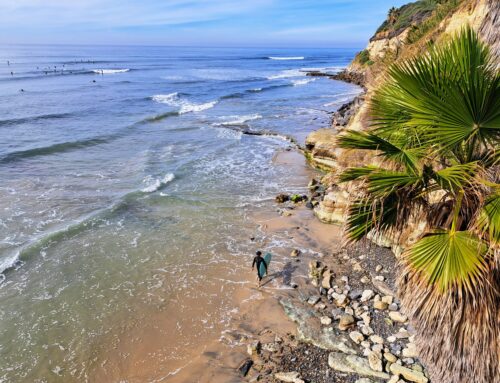 One of our favorite toys is the Hobie inflatable kayak. It can be paddled like a regular kayak or pedaled much like a bike leaving your hands free to take photos or sip your morning coffee. The kayak, a Hobie i11s, is extremely stable and fast due to its flat bottom and the raised chair keeps your bottom dry. It can carry a bunch of gear to go snorkeling or head to the beach for a picnic.
One of our favorite toys is the Hobie inflatable kayak. It can be paddled like a regular kayak or pedaled much like a bike leaving your hands free to take photos or sip your morning coffee. The kayak, a Hobie i11s, is extremely stable and fast due to its flat bottom and the raised chair keeps your bottom dry. It can carry a bunch of gear to go snorkeling or head to the beach for a picnic. 

 While Limerick is under shrink-wrap for the winter, we drove to San Diego to be with family and get some sunshine. So we aren’t left entirely boatless we took the inflatable kayak along.
While Limerick is under shrink-wrap for the winter, we drove to San Diego to be with family and get some sunshine. So we aren’t left entirely boatless we took the inflatable kayak along.  We usually use our fishfinder and chart plotter combo in the dinghy but wanted to make it work for the kayak as well. To power the fishfinder we have this awesome lithium-ion battery — if you’re in the market, be sure to get the heavy-duty model as the other is not powerful enough to power the fishfinder. We did have to purchase a new mount for the transducer and drill a couple of holes into the rudder. We also picked up a kayak cart to make it easier to move the kayak down the ramp or beach from the car. The kayak itself is fairly lightweight but once it is loaded down with gear the wheels are really helpful.
We usually use our fishfinder and chart plotter combo in the dinghy but wanted to make it work for the kayak as well. To power the fishfinder we have this awesome lithium-ion battery — if you’re in the market, be sure to get the heavy-duty model as the other is not powerful enough to power the fishfinder. We did have to purchase a new mount for the transducer and drill a couple of holes into the rudder. We also picked up a kayak cart to make it easier to move the kayak down the ramp or beach from the car. The kayak itself is fairly lightweight but once it is loaded down with gear the wheels are really helpful.  The screen is attached to the chair’s built-in mounting bracket with zip-ties.
The screen is attached to the chair’s built-in mounting bracket with zip-ties. 


 One of the best features of this fishfinder is that it can transmit depths via wifi and then plot those to the Navionics charting app on the tablet or phone. It’s great for scouting out a new anchorage or finding that perfect spot to drop the shrimp pot. Before we surveyed this bay there were only two soundings on our chart.
One of the best features of this fishfinder is that it can transmit depths via wifi and then plot those to the Navionics charting app on the tablet or phone. It’s great for scouting out a new anchorage or finding that perfect spot to drop the shrimp pot. Before we surveyed this bay there were only two soundings on our chart.  Years ago we found this awesome air pump at a whitewater rafting shop. It is made of PVC pipe and virtually indestructible. It stows easily and pumps much faster than other pumps, especially to high pressure which we need for the SUP. To check the pressure for our kayak, as well as the dinghy, we use a low-pressure gauge since both are supposed to be inflated to around 3 psi. We also have a high-pressure gauge for the inflatable SUP which should be around 10-15 psi.
Years ago we found this awesome air pump at a whitewater rafting shop. It is made of PVC pipe and virtually indestructible. It stows easily and pumps much faster than other pumps, especially to high pressure which we need for the SUP. To check the pressure for our kayak, as well as the dinghy, we use a low-pressure gauge since both are supposed to be inflated to around 3 psi. We also have a high-pressure gauge for the inflatable SUP which should be around 10-15 psi. The transducer is attached to the rudder with the new mount. If the rudder hits anything it will just kick up, protecting the rudder and the transducer.
The transducer is attached to the rudder with the new mount. If the rudder hits anything it will just kick up, protecting the rudder and the transducer. 







[…] stayed for a week and took the inflatable kayak to the beach every day to go snorkeling. With a little hike from the parking area, we had […]